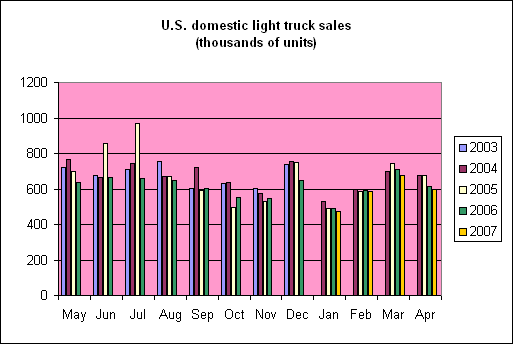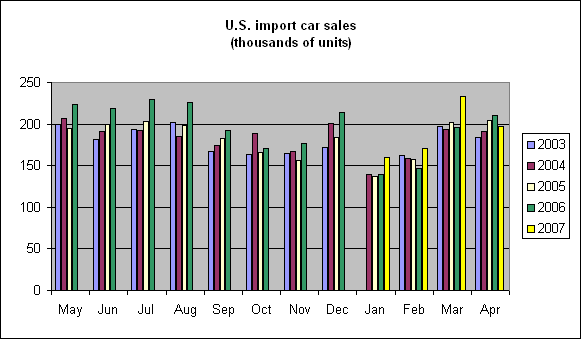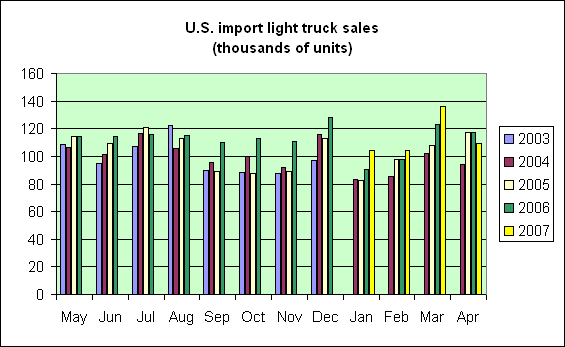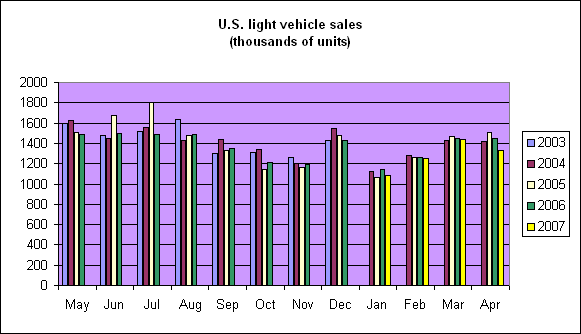The number of new cars and light trucks sold in America was down nearly 8% in April relative to the previous year. That’s a significant deterioration of the recent downward trend, but not yet a catastrophic plunge.
The number of domestically manufactured cars has been falling on average by 1% each year over the last four years. But the 15% drop last month is a significant deterioration relative to that trend. Sales of domestic light trucks, which had been falling 2% per year, fell 3% in April.
 |
This spring’s run-up in gasoline prices doubtless played a role. But there are important differences between what we see happening to auto sales now, and the consequences of the gasoline price increases following the hurricanes in the fall of 2005. In that earlier episode, it was light truck sales (in which SUVs get counted) that took the big hit, whereas last month, sales of cars fell much more than light trucks.
 |
Another important difference is that in the fall of 2005, domestic car sales fell much more than imports. By contrast, last month Toyota, Honda, and Nissan all shared the pain.
 |
 |
A final difference is that the overall magnitude of the April drop, as measured by the percent change in the total number of vehicles sold, is only about half that observed in October 2005:
 |
I conclude that so far this is not looking like a replay of the very sharp drop in domestic auto sales that we saw in the fall of 2005, which drop shaved a full 1% off 2005:Q4 GDP growth. Although rising gas prices may have been a factor in the April sluggishness, I agree with Kash Mansori that the current data are more likely to be an early signal that slowing income growth and a perhaps a reduction in mortgage equity withdrawal are starting to show up in consumption spending.
So far, the magnitudes are ones we can live with. And it’s always a mistake to make too much of one month’s data. But the April vehicle sales certainly raise the level of concern.
Technorati Tags: macroeconomics,
autos,
auto+sales
Auto prices are up significantly. This is not reflected by actual sticker prices, but in a reduction in incentives.
Also, auto sales set records in ’02, ’03, and ’04. We shouldn’t be surprised that sales are decreasing now. Cars last a long time. I expect to keep my ’01 until ’21!
I think there’s a very real possibility of a negative feedback loop here – the poor and lower-middle class disproportionately buy American cars and trucks; economic weakness affects those people first; they buy fewer cars and trucks; leading to more economic weakness which affects those people first…
The BEA seasonally adjusted annual rate auto sales number is 16.280 M as compared to 16.565 M 1st Q
average and 16.320 in March. I’m not sure how the decision to quit selling autos to rental companies at deep discounts impacts these numbers, but it still looks like sales are still bouncing around the flat trend they have been in since 2000. Sales continue to be weak, but they are not deteriorating significantly.
Sales will continue to fall; look at that weak employment growth (despite, per Big Picture, the unbelievable birth/death adjustment).
Time to get ahead of the curve and revert to the ‘frowny’ emoticon! Next week’s weak retail sales should seal the deal.
JDH,
Help me understand the numbers.
Do domestic sales include vehicles manufactured in the US by foreign companies?
Is there a decline in total vehicle sales both domestic and foreign?
Is the drop in sales out of bounds for an average over the previous three to six months given the apparent increase in March 2007?
DickF, yes, “domestic” refers to manufacture, not brand. The final (purple) chart is domestic plus imports combined. All 5 categories (domestic cars, domestic light trucks, import cars, import light trucks, total) show decline.
All my statements were year-to-year comparisons (April 2007 vs. April 2006), but of course with the charts you can make whatever comparison you’re interested in. The strong March 2007 numbers you refer to are for imports, not domestic or total.
About the stats from q3 and q4 of 05 and 06 where we saw (allow me to avoid visiting those stats which I spent way too much time on predicting something quite a bit lower than the 3.5 advance GDP number for 06) the domestic industry distress via generous incentives which brought sales forward to provide very lofty q3 numbers and devastating q4 ones, yes? Had there not been this glut of year old models to dump (ie if management had calculated production requirements with more care) there would not have been this need to apply incentives and the volatility we saw across those 2 quarters would have been less.
We now have a leaner meaner Ford, GM (and so far Chrysler hasn’t been spun off by Daimler) companies, the executives are telling us (check those compensation packages to see really what this means) that aren’t interested in volume, just profitable production.
So look forward to more downsizing…in the end it’ll be Mallaly and Wagoneer wrenches in hand trying to bolt the thing together: lefty loosey, righty tighty…only their mothers will be buying those cars.
Car Sales Poised to Plunge?
Are automobile sales poised to plunge? The April data have prompted worry from bloggers Kash at The Street Light and Jim Hamilton at EconBrowser. Car sales may edge down, but don’t think that we’ve over-bought cars in the past few
Thank you Professor.